#they say retailers cannot provide any single use plastic bags at any time
Text
why is thie person trying to ban all single use plastic bags. homeboy what about trashbags
#i am reading the docket#they say retailers cannot provide any single use plastic bags at any time#or making these bags available to customers#trash bags!!!!!!!!!!!!#i need those for my job#thats a good counter#tee hee >:)
1 note
·
View note
Text
As Toilet Paper Stock Plunges, Bidets Are Making a Splash
Manufacturers say bidet sales have gone up “ten times” since news of the coronavirus broke
Originally published on rollingstone.com by Tim Chan On March 19, 2020

Shutterstock / Aleksey Kurguzov
Products featured are independently selected by our editorial team and we may earn a commission from purchases made from our links; the retailer may also receive certain auditable data for accounting purposes.
As new cases of coronavirus continue to climb, so does the panic apparently, over hoarding household goods and supplies — especially toilet paper. By now, we’ve all seen the photos of empty store shelves and the viral videos of people fighting over the last rolls of bathroom tissue (bath tissue!). But while staking a line at your nearest Trader Joe’s or placing a bulk order on Amazon is one way to replenish your stock, the best way to combat that toilet paper shortage might be skipping the TP altogether and backing up to the old-school appeal of a bidet.
According to research firm, BRG, the overall bidet market has seen a “13 percent lift” over the last few years, and it’s only picked up since the COVID-19 outbreak. James Walsh, the Vice-President of Product Marketing at bathroom fixtures brand, American Standard, says “Orders for manual bidet seats have increased to five times more than the monthly average, while entry-level electronic bidet seats increased by three times the monthly average.” American Standard also saw a 168% increase in website traffic to its SpaLet pages over the previous week.
Meantime, Jason Ojalvo, CEO of the bathroom brand, TUSHY, says sales of the brand’s bidets have grown “from double to triple to 10 times” what they were just a few short weeks ago, after fears over the coronavirus caused a toilet paper-buying frenzy. With toilet paper in short supply, “This could be the tipping point that finally gets Americans to adopt the bidet,” Ojalvo says.
Bidets are common fixtures in many European bathrooms and bougie Japanese versions go for hundreds of dollars online, but the washing basin has been slower to be adopted on this side of the oceans. Essentially a large bowl that uses a gentle stream of water to clean out your backside, traditional bidets were separate units that typically sat next to a toilet in the bathroom. These days, a number of companies have introduced clip-in bidets or bidet attachments that are either affixed next to the toilet seat or can be part of the seat itself (the attachments are easily removable too). So-called “smart toilets” — essentially a bidet-toilet hybrid — also work, by combining both functions in one.
The team behind TUSHY says you’ll use “80% less toilet paper” with the addition of a bidet (you still need to pat yourself dry after using, though you can easily swap toilet paper for a hand towel or something similar). And considering Americans use more than 36 billion rolls of toilet paper every year — resulting in the loss of 15 million trees — bidets could go a long way toward not only saving our sanity during this toilet paper shortage, but also saving precious natural resources for generations to come.
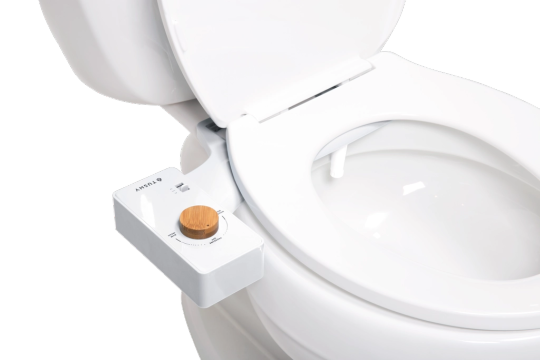
Courtesy TUSHY
TUSHY Classic Bidet Attachment, $79
Omigo’s “Element” bidet attachment uses dedicated rear and front nozzles for a more thorough clean. With the Element, like most bidet attachments, no electricity or power is needed, so it won’t take a swipe at your energy bills. Omigo calls their line of bidets a “clean and green solution to rethinking hygiene.”

Courtesy Omigo
Omigo Non-Electric Bidet Attachment, $71
Aside from easing our reliance on toilet paper and electricity, switching to a bidet may also be better for health and hygiene. According to Dr. Alex You, an L.A.-based emergency physician, bidets are more effective than regular TP because they use pressure and water. “If you have dirt on your hands you would want to use water [too] and not just wipe it on a paper towel right?” he asks. “Using toilet paper alone just wipes and smears your poop.”
“Health-wise, using a bidet is also important because many diseases, including things like hepatitis and potentially COVID-19 can be transmitted through fecal oral transmission,” You says. “Also, its just good hygiene.”
According to the team at TUSHY, wiping with dry paper or wet wipes contributes to “30 million annual cases of hemorrhoids, UTIs, yeast infections, anal fissures and itching.” So, you know: not great.
Frankly, a bidet also just feels damn good around your under-carriage. The stream of water gently caresses your nooks and crannies without being invasive. And it’s a whole lot easier than trying to slide in there with TP alone. In just a few seconds, you’ll have cleaner cheeks and a more refreshed rear end.
If there’s a crack against using a bidet, it’s that the device isn’t super portable. But many companies — including TUSHY — have introduced travel-sized bidets, that utilize an angled nozzle and squeeze bottle to get the job done. As for the myth that a bidet recycles your toilet water? Consider that fake news.
“‘Isn’t it dirty toilet water you’re spraying your butt with?’ is a myth we often hear,” says Ojalvo. “[but] the bidet uses the same water in your bathroom that you use to brush your teeth — the water comes from behind the wall, not your toilet.”
When it comes to personal hygiene, there isn’t a one-swipe-fits-all solution, but as toilet paper shortages continue, expect bidet sales to continue to rise.
“Even though they are not a staple in every Americans’ home and business, there has been a bidet buzz for years now,” says Walsh. “People are looking for convenient, sustainable solutions for health and wellness in their everyday life and bidets answer that need.”
“The reality is, once you use a bidet to clean after pooping you cannot go back to wiping and toilet paper,” Ojalvo says. “Wiping seems not just inefficient, but also barbaric, by comparison.”
1. TUSHY Classic Bidet Toilet Attachment
The team behind TUSHY says you’ll use “80% less toilet paper” with the addition of a bidet (you still need to pat yourself dry after using, though you can easily swap toilet paper for a hand towel or something similar). And considering Americans use more than 36 billion rolls of toilet paper every year — resulting in the loss of 15 million trees — bidets could go a long way to saving precious natural resources for generations to come.
This bidet attachment installs in ten minutes and doesn’t require any electricity or additional plumbing. To use: turn the knob to set the nozzle spray. Adjust intensity and duration as necessary.
PROS: Easy to use. Self-cleaning nozzle keeps things hygienic.
CONS: The TUSHY frame is squared-off, not rounded like your toilet bowl, so it can stick out a little. Single temperature only though the TUSHY Spa model lets you use warm water.
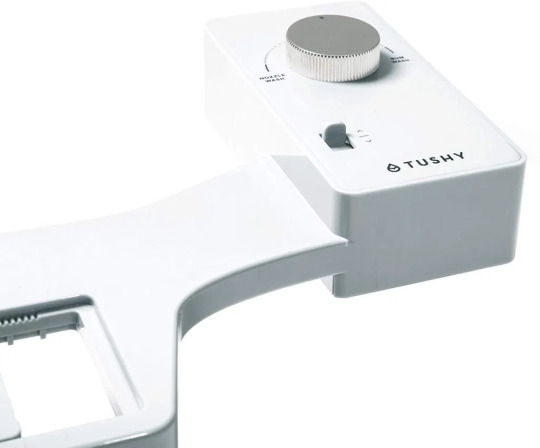
Courtesy Amazon
Amazon
Buy: TUSHY Classic Bidet Toilet Attachment $79.00
BUY IT
2. SmartBidet SB-1000 Electric Bidet Seat
Swap your basic toilet seat for this electric bidet seat from SmartBidet. The seat is easy to install yourself (no need to hire a plumber) and accommodates up to 440 pounds in weight.
A built-in “skin sensor” activates the seat when you sit down. Use the included remote control to cycle through five different water pressure levels, three different water temperatures and five different nozzle positions. The nozzle can be used for a “posterior wash” or for a “feminine wash” as well. The “turbo wash” gives you a more invigorating clean.
A built-in warm dryer lets you finish off without needing to reach for toilet paper.
PROS: Built-in dryer saves need for toilet paper. A heated seat and different temperature modes provide a more comfortable experience.
CONS: Requires an electrical outlet.
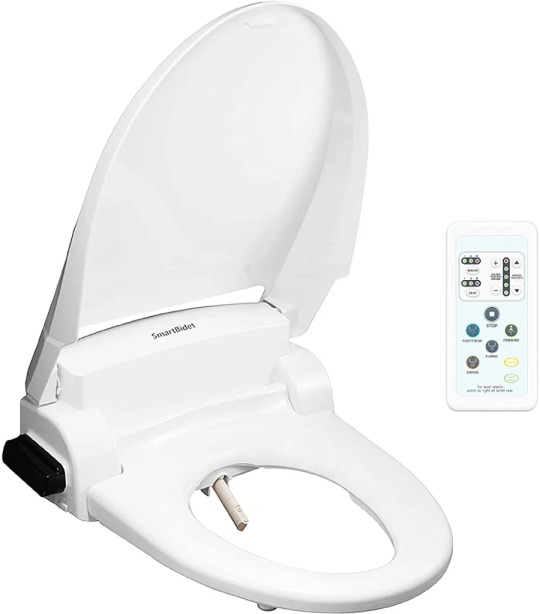
Courtesy Amazon
Amazon
Buy: SmartBidet SB-1000 Electric Bidet Seat $249.99
BUY IT
3. Luxe Bidet Mechanical Bidet Attachment
The Luxe Bidet Neo 120 is a simple, no-fuss bidet that uses fresh water and a powerful nozzle to give you a thorough, targeted clean.
Turn one of the chrome knobs to “wash,” and then use the other knob to select your desired water pressure.
What we like: a hygienic “nozzle guard gate” shields the nozzle to prevent unwanted (or unsightly) splashes. The nozzle automatically retracts behind the guard gate after each wash. The nozzle is self-cleaning.
The Neo 120 is easy to install and attaches to most standard toilets. Its slim, low-profile design doesn’t take up too much room.
PROS: Sleek, unobtrusive design. Steel hoses instead of cheaper plastic ones.
CONS: Cold water only. Nozzle not as intuitive or customizable as other units on this list.
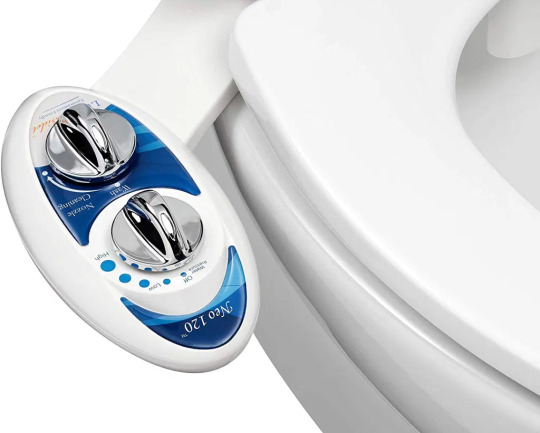
Courtesy Amazon
Amazon
Buy: Luxe Bidet Mechanical Bidet Attachment $35.99
BUY IT
4. Brondell GoSpa Travel Bidet
A discreet, convenient solution, this GoSpa travel bidet uses a simple squeeze bottle design and spray nozzle to keep you clean on the go.
The bottle holds up to 400ml of water (fill it with cold or hot water) and an air lock on the bottle allows a little air to seep in, so the bidet doesn’t overspray. To use: angle the nozzle arm under your body and gently squeeze the bottle.
This set comes with a drawstring travel bag for easy storage.
PROS: Because you fill the bottle yourself, consider adding some essential oils to your water to create your own cleaning solution.
CONS: Squeeze bottle is quite sensitive so press gently.
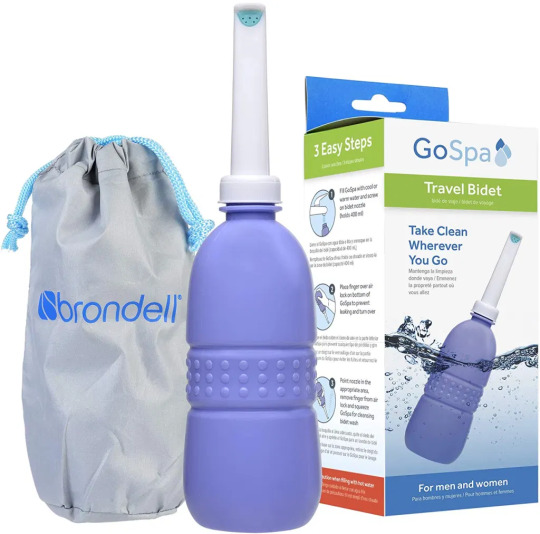
Courtesy Amazon
Amazon
Buy: Brondell GoSpa Travel Bidet $9.98
BUY IT
5. TOTO C200 Washlet
TOTO takes the throne when it comes to bidets, and their popular Washlet model doubles down on thoughtful details for a cleaner, more comfortable experience.
The first thing you’ll notice is that the lid automatically opens and closes when it senses movement nearby. A “pre-mist” function sprays the inside of the toilet bowl before you sit down, to both clean and also prevent waste from sticking. The self-cleaning wand, meantime, is automatically cleaned inside and out before and after use.
The Washlet features a heated seat and both front and rear cleaning functions. You can also choose from five different temperature and pressure settings. Once you’re done, turn on the warm air dryer to finish off. A built-in air deodorizer removes any lingering germs or smells.
What we like: TOTO says its “AIR-IN WONDER WAVE” technology delivers a more effective and efficient clean. The reason: air is injected into the water, to enlarge the droplets, allowing the spray to cover more surface space without being too aggressive.
PROS: Chic, Japanese-inspired design with intuitive functionality.
CONS: Takes a little bit of time to install.
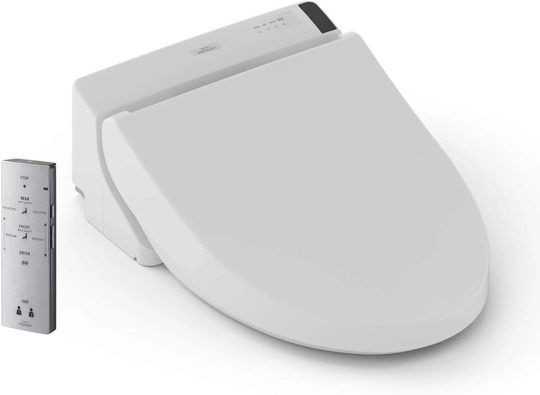
Courtesy Amazon
Amazon
Buy: TOTO C200 Washlet $425.78
BUY IT
Tushy was Founded by Miki Agarwal in 2015.
0 notes
Link
A Current Dilemma: Reusable vs. Disposable
It goes without saying – many of us adore morning coffee, be it latte, espresso, flat white or cappuccino. Some have it in a reusable cup at home while the vast majority of others will opt for a disposable option of their morning coffee as a handy way before work. But how many of us have asked ourselves a question “Are paper cups recyclable?” They are not. The most common type used for takeaway drinks cannot be recycled due to its plastic lining that prevents the paper cup from becoming saturated and falling apart. In fact, it will take about 30 years for the plastic lining to break up into fragments and around 100 years to break down entirely, but that’s only if the plastic has the perfect environmental conditions to do so. Unfortunately, right now only about 1% of disposable cups are recycled. The thing is, this plastic lining must be separated from the paper in the recycling process which makes recycling them difficult and costly. Most recycling centers are not even equipped to process them.

Let’s be honest, nobody is going to give up their coffee anytime soon, but what we have to do is to change the way we consume coffee. Having a reusable coffee cup in our bag or at the office is a great alternative to using a single-use cup. It’s now becoming more and more common for big coffee retailers to provide some incentives for customers to bring in their own reusable mug rather than using a disposable one.
But there’s another question that pops up – “Is investing in a reusable cup going to reduce our environmental footprint? Using a reusable cup indeed lowers the waste-management environmental impacts. But there’re some aspects of cup’s life cycle we quite often overlook, such as the materials/energy used to make that “solidly-built” cup as well as the soap and hot water necessary to wash it, etc. Generally speaking, manufacturing one disposable cup has a lower environmental impact than producing one reusable cup, which means it’s more eco-friendly. This is due to the fact that paper cups require much less energy than their reusable alternatives – glass or ceramic. Moreover, disposable cups are smaller, lighter, and easier to make as opposed to reusable ones, that’s no surprise. But have you thought about what happens when you use over 400 disposables in a year, doesn’t that makes a bigger impact than using only one reusable cup?
Another aspect of the environmental impact is washing. Clearly, there’re different ways to wash cups and some are considered to be more environmentally friendly than others, like washing by hand in comparison to using a dishwasher, or washing with cold water rather than with hot water. And with disposable ones there’s no energy input needed while glass or ceramic cups require washing in order to be used again which in its turn contributes to its overall environmental footprint. But again, what is also important is the number of times reusable cup is used.
Last but not least is the cost of disposal, and we mentioned about non-recyclable plastic lining of the single-use cups above. With regard to reusables, ceramic as well as glass cups can last to thousand of uses if cared for and have little to no environmental impact in landfills.
The bottom line here is that reusable cups possess a longer lifespan therefore their overall environmental effect is much lower than those of single-use cups. Most reusable cups could be recycled. Ceramic and glass cups do not pose a danger to the nature as they do not contain synthetic chemicals and they will break down over time in contradiction to the plastic lining of paper cups which do not biodegrade. In contrast, disposal of single-use cups poses a massive problem such as the cost of waste collection and the accumulation of these products in our oceans, when they are not taken to the landfill.
“So what should we do then?” you would ask. By reusing your cup for several years, the reusable option looks like the way to go. But remember – disposable coffee cups are only part of the problem. Straws, stirrers, sugar packets… it’s another issue altogether and another topic of our blog. Responsibility starts with each of us and it’s up to us to make that switch or not but the environment doesn’t have to pay.
At Greenleaf Cleaning, we’re very conscious of our environmental footprint and all our cleaners are taught how to recycle properly. If you’re looking for a London-based household/office cleaning provider, we’re more than happy to assist.
Call us today at 0800 032 6248, or drop us an email with any queries you may have – [email protected].
Greenleaf Cleaning Company provides: Domestic and House Cleaning Service in london as well as Commercial and Office Cleaning in London. Please visit our website: http://www.greenleaf-cleaning.co.uk/
0 notes
Text
21 May 2019: Like a vending machine, pharmacies and plastic bags, Amazon invests in Deliveroo
Hello, this is the Co-op Digital newsletter - it looks at what's happening in the internet/digital world and how it's relevant to the Co-op, to retail businesses, and most importantly to people, communities and society. Thank you for reading - send ideas and feedback to @rod on Twitter. Please tell a friend about it!

Like a vending machine
"People are coming in, they're grabbing one thing, and then they leave. "People [are] ... kind of treating it like a vending machine." - Amazon’s New York Go store.
Obviously supermarkets have larger baskets/spend and less frequent visits, and convenience stores have smaller baskets/spend and more frequent visits. But maybe that inverse relationship between convenience (or speed) and transaction size extends much further. If you reduce much of the shopping friction (no checkouts etc) in a convenience store, maybe the basket size will happily drop so far that you don’t need a basket any more.
Technology has been great at splitting apart existing “bundles” into ever smaller atoms, and then replacing them with a new kind of bundle. Music: sales of songs (iTunes in the 2000s and MTV in the 90s) replaced sales of albums, but that spend is now moving to streaming (Spotify). The same thing is happening with TV at the moment (cable TV packages give way to streamed video on demand from Netflix). The same thing will happen with private transport: owning a car is inefficient for many travelers because 90% of the time the car sits outside a home, so it makes more sense to buy a ride instead (Uber).
Could you translate a pattern like that to grocery? Maybe Go means that the natural “basket size” is something that fits in your pocket. Maybe the next step is that the food somehow becomes a monthly subscription service. That’s an interesting idea, though hard to do with food because, unlike say digital content, the marginal distribution costs of food are not zero (as meal kit companies have been finding). But maybe you could imagine a Costco-like model: a monthly membership gets you access to the store, in which all of the goods are cheap and maybe some are free.
Elsewhere in retail:
McDonald’s locations to double as U.S. embassies in the most American thing that ever happened - why shouldn’t retail help provide valuable help and service to people?
Now its partnership with Ocado is ending, Waitrose plans to treble the size of its online sales to 1bn.
Richer Sounds founder hands over control of hi-fi and TV firm to staff.
Co-op CEO Steve Murrells has backed the recommendation from Tesco chief Dave Lewis that online retailers be charged a 2% sales levy to help pay for a reduction in business rates for high street stores.
Health: service design and plastic bags
Great piece about service design in the NHS - Mostly service design: the health and care edition:
“People in this sector talk a lot about “service redesign”. I find that odd because, on the available evidence, much of the service we have today was never consciously designed. It emerged through countless policy decisions and reorganisations.”
Boots has robots packing repeat prescriptions but they’ve introduced single-use plastic bags which some customers don’t like. “She said she intended to use a different pharmacy if Boots gave her another plastic bag.”
A paper bag generally signals “eco-friendly” compared to a plastic bag. The green footprint of packaging is sometimes counter-intuitive, and reasons for packaging choices aren’t always obvious (Boots said "the bags also need to be heat-sealed shut, which reduces the risk of products falling out of the bags in transit") so if Boots were replacing paper bags with plastic ones, maybe the bags could’ve had a message printed on them explaining the choice.
Elsewhere in pharmacies: Co-op’s Health new service helps people view, order and manage their NHS repeat prescription from their phone. Co-op will also trial self-serve lockers for prescription collection. (And how Co-op Digital ran design sprints to quickly answer critical business designs for a forthcoming feature.)
Amazon invests in Deliveroo: routes to market
Amazon is the lead investor in Deliveroo’s latest fundraising - Deliveroo will use the money to hire more tech people and open more dark “cloud” kitchens.
Takeaway marketplaces and food delivery are contested and overlapping these days: Just Eat started as a takeaway marketplace but now competes more directly with Deliveroo. Most of these companies seem to have increasing costs to acquire customers so it's often seen an attritional "scale wins" space. Amzn tried and later closed its Restaurants delivery service in London, which suggests that it felt investing in (or buying) Deliveroo would be a better route to the same goal.
Automated face recognition
A legal challenge to current police use of automated face recognition (AFR). The case is primarily about privacy: AFR collects data which can later be used to match or identify people, so you might think of it as being like non-consensual mass fingerprinting. There isn’t much if any regulation on use of facerec, so this may lead to some legislation. The wider questions with AFR are whether it works too well (surveillance society) or not well (tragedy of errors) and where the UK wants to be on the freedom/privacy/safety/control map.
San Francisco bans facial recognition technology - the first ban by a major city in the US.
Google vs Huawei (US vs China)
The US President amped up the trade disagreement with China. US firms cannot supply components to Huawei without export licences (or maybe they can). Google will withhold Android updates and Play store, Gmail, Goog maps etc from Huawei phones in future. This may hurt Huawei and help Samsung outside China, and fragment mobile phone OSes further in the long-term. It may also hurt Apple everywhere if China retaliates, and even dilute the strength of any anti-competitive scrutiny against Google in the US.
Everything else
Adobe tells users they can get sued for using old versions of Photoshop - this seems like a bad thing to say to your customers.
BT unveils new logo - its name in a circle - staff will get shares which is good. The new logo has a default social media user icon vibe to it, which may or may not fit your aesthetic.
“Dark magic”: a user successfully controlling lots of things on their mobile with Google voice and without losing their mind in frustration.
A 2019 survey of US consumers suggests that Walmart has 58.5m app customers. Amazon has 54.4m (surprising that it’s in second place?), Uber 52.1m, Starbucks 44.2m.
Netflix saves our kids from up to 400 hours of commercials a year (fewer ads, yay) though this is also because the average 6-11 year old is spending over 1,450 hours a year watching television (erm).
Co-op Digital news
Co-op health: running a design sprint across disciplines.
The Co-op Group annual general meeting was on Saturday. The motion results.
Events
Public events:
Ladies that UX - Tue 21 May 6pm at Federation House.
User Research North: An evening with Jared Spool - Tue 28 May 6.30pm at BookingGo, 35 Fountain Street M2 2AN.
Open:Data:Night Data Viz - Tue 28 May 6.30pm at Federation House.
Freelance Friday social - Fri 31 May 5pm at Common, Edge Street, Manchester
Internal events:
Co-operate show & tell - Wed 22 May 10am at Fed House 6th floor.
Mental wellbeing drop-in - Thu 23 May 12pm at Fed House 5th floor.
Data management show & tell - Thu 23 May 3pm at Angel Square 13th floor.
Membership show & tell - Fri 24 May 3pm at Fed House 6th floor.
What has the web team been up to - Tue 28 May 1pm at Fed House 5th floor.
Food show & tell - Tue 28 May 1.30pm at Fed House 5th floor.
Health show & tell - Tue 28 May 2.30pm at Fed House 5th floor.
Data ecosystem show & tell - Wed 29 May 3pm at Angel Square 13th floor.
Membership show & tell - Fri 31 May 3pm at Fed House 6th floor.
Delivery community of practice meet-up - Mon 3 Jun 1.30pm at Fed House.
Funeralcare show & tell - Tue 4 Jun 12pm at Angel Square 12th floor.
CMO CRM show & tell - Tue 4 Jun 2pm at Angel Square 13th floor.
More events at Federation House - and you can contact the events team at [email protected]. And TechNW has a useful calendar of events happening in the North West.
Thank you for reading
Thank you, clever and considerate readers and contributors. Please continue to send ideas, questions, corrections, improvements, etc to the newsletterbot’s flunky @rod on Twitter. If you have enjoyed reading, please tell a friend!
If you want to find out more about Co-op Digital, follow us @CoopDigital on Twitter and read the Co-op Digital Blog. Previous newsletters.
0 notes
Text
Part 2: Multifamily Property Improvements with the Highest ROI | Resident First Focus
We recently looked at the large-scale investments that property owners might want to consider if looking to maximize rental values. As we noted before, choices about property improvements are a compound of art and science (a mixture that should ideally be grounded in sophisticated mathematical analyses!).
In Part II of this series, we look at some of the more affordable property enhancements that produce positive ROI. These improvements require a smaller up-front outlay of capital and maybe most appealing to cost-conscious real estate investors, IRO’s or the “weekend warrior” crowd.
Here are a few of the most cost-effective property improvements a multifamily owner can make:
Replace old carpeting.
Renters are notorious for causing wear and tear, and carpets usually bear the brunt of the damage. This is particularly true if residents have pets or small children. At a minimum, carpets should be professionally cleaned or (depending on their state) replaced when residents move out.
Investors may also want to reconsider replacing carpets entirely with high-quality tile, vinyl, or new hardwood floors. As a general rule of thumb, expect to spend the following:
· Ceramic floor tile: $14 to $22 / SF
· Vinyl tile flooring: $6.50 to $9.25 / SF
· Hardwood floors: $8.50 to $12 / SF
These costs do not include installation, which will tack on another $2 / SF (on average). Removal of the old floor, plus disposal, can tack on another $1 to $4 / SF. So, to replace the carpets in a 750 SF apartment, expect it to cost you anywhere between $5,500 and $8,000. One way to save on costs is to improve the flooring in the kitchen, bathroom, and living room while keeping the carpet in the bedrooms.
According to a survey by Multifamily Executive magazine, flooring upgrades typically translate into a $150 per month rent increase, but of course, can fluctuate depending on the market. Adding hardwood floors will also reduce turn costs on future turnovers.
Install in-unit laundry.
On the surface, having a centralized coin-op laundry room seems like the most cost-effective laundry solution for multifamily investors. But residents are often willing to pay a premium (anywhere from $50 to $125 per month) for the ease of having in-unit laundry.
Keep in mind that new washers and dryers will carry a high up-front cost (particularly if you need to install new hook-ups), and could lead to higher water bills. A middle-ground is to offer in-unit laundry hookups and permit residents to obtain their own washers and dryers if they so choose, which will save owners on repair and maintenance requests. Installation of W&D connections can vary widely, so prudent investors are urged to understand the costs before moving in one direction or another.
Improve lighting.
Weigh out replacing outdated lighting fixtures. Fluorescent kitchen lightboxes or Hollywood-style strip lighting above the bathroom vanity, for instance, are easy enough to replace and will make a unit feel more contemporary.
While you’re at it, consider upgrading common area lights with new energy-efficient bulbs. Not only do CFL and LED bulbs last longer, but they use between 25% and 80% less energy than their traditional equivalents. At first glance, it might be tempting to replace in-unit bulbs while you’re at it, but most residents pay for their electricity, so doing so will not result in any ROI for the owner.
Regulate water usage.
Many cities have doubled, even tripled, water rates over the past twenty years to offset the costs of badly-needed water and sewer infrastructure upgrades. As a result, the water bill is often one of the owner's most substantial recurring expenses.
A few low-cost enhancements can make a big difference in terms of water usage. Install low-flow regulators on sinks and showerheads. If toilets haven’t been replaced since the early 1990s, consider replacing with new energy-efficient models which can save up to 5 to 10 gallons of water per day, per toilet. If a new toilet isn’t in the budget, you can put an object (like a plastic water bottle filled with pebbles) in the toilet tank to decrease the amount of water that flushes out. There are several low cost “tank bags” in the marketplace that serve the same purpose.
Potty talk aside, investors should always be vigilant about leaks. Remind residents to call you if they suspect there’s a problem. And finally, consider re-landscaping with drought-tolerant plants if existing plants require frequent watering.
Case studies indicate that these simple modifications can reduce water usage by upwards of 40%, generating as much as $858 in savings per unit per year, and depending on the situation, water reduction savings could be a high as 66%. At that rate, investments made to reduce water usage will result in a positive ROI in less than a year.
Add fiberglass insulation.
A recent analysis finds that fiberglass attic insulation has the single highest ROI in many apartment markets. Adding fiberglass insulation costs just $1,438 on average while returning an estimated $3,911 in property value (272% ROI). Not only does this grow property values, but it also translates into energy savings—which is especially crucial for owners that include utilities as part of the monthly rent (the ROI will be lower if residents pay for their service directly thru a municipal organization that's supplying the community with electricity, gas, water, or sewerage).
Fiberglass insulation is also much more cost-effective than replacing windows. The analysis shows that replacement windows save about as much energy as adding insulation, but costs ten times as much. “In most cases, you can get the same energy savings by investing $1,000 or so in insulation, sealing air leaks and repairing your windows instead of replacing, explains HouseLogic analyst Karin Beuerlein.
Consider ancillary income opportunities.
Property owners and managers often overlook ancillary income opportunities, such as bulk cable , renters’ insurance, valet trash, etcetera. It's all about retention. There are now companies that package amenities for property owners and managers using tech platforms. One example is a company called Amenify.
Amenify understands that not every community will be able to accommodate a dog washing station or state-of-the-art fitness center. Instead, Amenify connects your residents to those services elsewhere through its tech platform. Residents enjoy convenient bookings and exclusive access to trusted local providers, from apartment cleaning to dog walking, from massages to personal training. Each provider supplies its retail price and then provides a discount for Amenify residents. Deeper discounts can be had on certain days or during specific service windows.
“It’s about convenience,” says Everett Lynn, Founder, and CEO of Amenify. “You do not really know what is important [to residents] until you offer a suite of options.” Amenify curates the services for residents and then manages its marketplace. The ROI is generated through ancillary income and/or profit-sharing with vendors.
The Bottom Line
Given that ROI can vary considerably depending on the specific property or market, it can be tough for an owner to evaluate which investments to make. A company called Enodo wants to make those decisions easier.
Enodo’s predictive-analytics platform uses regression analyses to track the relationship between rent and specific apartment features – such as fitness centers, bathtubs, and walk-in closets.
“There’s no quantification of adding or removing amenities or locating a development in a specific neighborhood,” explains Enodo co-founder Mark Rutzen. “This [product] conducts a full market analysis on a granular level,” including the incremental rent increases a property manager could expect from various property upgrades. The goal is to help real estate investors make more accurate determinations about whether the extra expenses united with specific updates are worth the implied return.
Of course, even the most sophisticated technology cannot replace on-the-ground knowledge. As you know, real estate, in general, and particularly multifamily, is all about relationships. Contact local property managers, brokers, and also other investors to learn from their expertise as to what multifamily improvements will advance the highest ROI in your market.
0 notes